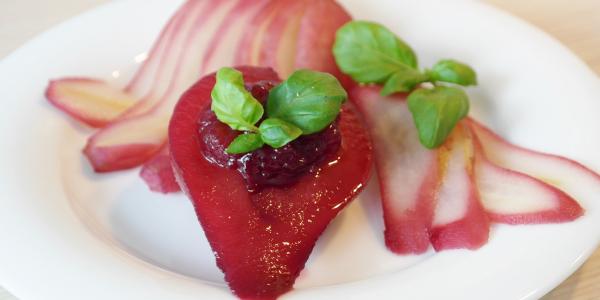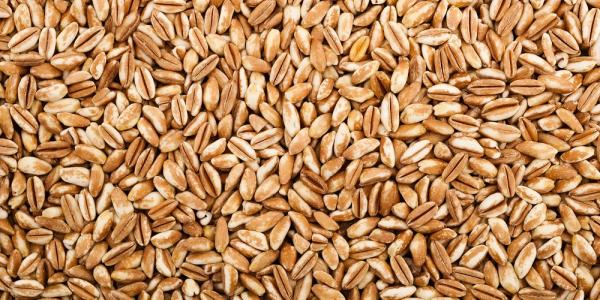Red Wine-Poached Pears

Ingredients
- 1 ¾ c. dry red wine, such as Cotes du Rhone, Pinot Noir or Merlot
- ½ c. port wine
- 1 ½ c. water
- 1 c. brown sugar
- 4 whole cloves
- Orange zest from ½ orange
- 1 t. vanilla extract
- 4 to 6 (about 8 oz. each) ripe but firm pears, preferably Bosc or Bartlett
Preparation
Bring wine, water and sugar to a simmer in a large saucepan over medium heat. Add cloves, zest and vanilla. Simmer for about 20 minutes then remove from the heat.
Peel the pears, halve them lengthwise then remove stem lines and cores. Add the pears to the wine syrup. The liquid should just barely cover the pears; add more wine and sugar if necessary. Place pan over medium heat and bring liquid almost to a simmer. Cook gently (poach), uncovered, for 10 to 15 minutes until the pears are tender (a toothpick can be inserted with little resistance).
Remove from heat and let cool in the syrup for at least 20 minutes and up to 1 day in the refrigerator. To serve, place pear halves in individual bowls and spoon wine syrup over the pears.
Learn More About Pears
In the world of fruit, pears seem to be second-bananas. Not to upset the apple cart, but why is there not a single pear saying, such as “an apple a day…” or “apple of my eye”?
Truthfully, pears are complicated. For instance, you would think that all pears are pear-shaped but, in fact, those classified as Asian pears are round (yes, like an apple). Asian pears have other similarities to apples: they are crisp, sweet and ready-to-eat right from the tree. Asian pears can be stored for a week or two at a cool temperature.
European pears, the ones with the traditional pear shape, are temperamental about ripening. If you went pear-picking and bit into one, you would be sorely disappointed. European pears must be picked before they’re ripe (in August and September), stored at a cool temperature (for weeks or months) and then held at room temperature (on your countertop) to finish ripening.
At the market, choose firm pears without blemishes and bruises. Store them at room temperature and check daily to see if they are ripe. Placing them in a paper bag speeds the process. The best sign of ripeness is to test the area around the stem of the pear. Press gently on the neck of the pear; if it yields to gentle pressure, it’s ready to use.
Since they store well, European pears are available from September through spring or summer of the following year. Choose Anjou as a citrusy-sweet and juicy all-purpose pear; Bartlett for its creamy, juicy, sweet flesh, musky aroma and traditional pear flavor; Bosc for its elegant shape and firm, honey-flavored flesh, perfect for cooking; and Comice for its red blush of color and mellow sweet flavor, just right for eating out-of-hand.
Try this month’s recipe for wine-poached pears, Chef Kurt’s version of the classic French dessert. Or pair a pear with a strong-flavored cheese. Either way, you’ll forget about apples.
Peggy Crum MA, RD
Featured Recipes

Rhubarb & Strawberry Crisp
Combine tart rhubarb with sweet strawberries, add a streusel topping, and bake until bubbly. Dessert doesn’t get easier—or more classic—than this. Serve warm with a scoop of vanilla ice cream. You’re sure to get rave reviews!

Farro Salad with Grilled Vegetables
Chewy farro grains are delicious in this autumn-y salad. Recipe yields enough for dinner for 2 to 4 with some left for a couple of lunches. To do this, make the base with dressing, farro, and grilled veggies. Add fresh veggies to the base as you go.

Pecan and Dark Chocolate Chip Cookies
Roasting amps up the flavor in everything including pecans. Chef Kurt's attention to detail takes a traditional chocolate chip cookie to another level of yum!

Onion Soup
Onions, the simplest of pantry staples, mingle with butter, broth, and herbs to become luxuriously smooth and delicious. Add "homemade" croutons and a blend of cheeses to make a complete and satisfying meal.





